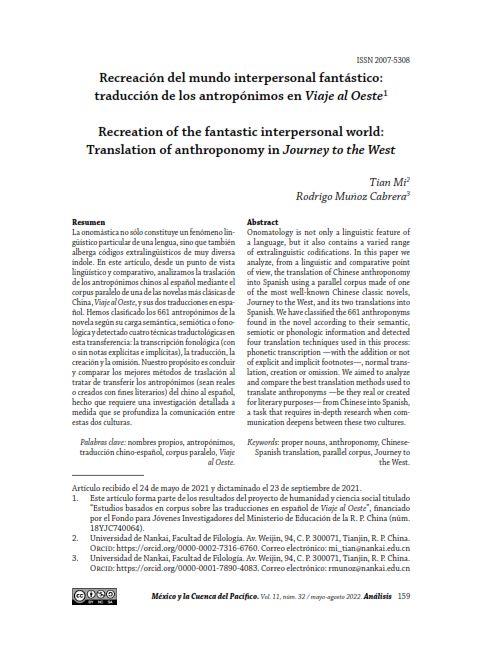Recreación del mundo interpersonal fantástico: traducción de los antropónimos en Viaje al Oeste
DOI:
https://doi.org/10.32870/mycp.v11i32.767Palabras clave:
nombres propios, antropónimos, traducción chino-español, corpus paralelo, Viaje al OesteResumen
La onomástica no sólo constituye un fenómeno lin-güístico particular de una lengua, sino que también alberga códigos extralingüísticos de muy diversa índole. En este artículo, desde un punto de vista lingüístico y comparativo, analizamos la traslación de los antropónimos chinos al español mediante el corpus paralelo de una de las novelas más clásicas de China, Viaje al Oeste, y sus dos traducciones en español. Hemos clasificado los 661 antropónimos de la novela según su carga semántica, semiótica o fono-lógica y detectado cuatro técnicas traductológicas en esta transferencia: la transcripción fonológica (con o sin notas explícitas e implícitas), la traducción, la creación y la omisión. Nuestro propósito es concluir y comparar los mejores métodos de traslación al tratar de transferir los antropónimos (sean reales o creados con fines literarios) del chino al español, hecho que requiere una investigación detallada a medida que se profundiza la comunicación entre estas dos culturas.Descargas
Citas
Adrada R. C. (2009). Antroponimia y connotación. La traducción al español de los nombres de persona en la obra de Molière [Tesis doctoral, Universidad de Valladolid]. https://www.educacion.gob.es/teseo/imprimirFicheroTesis. do?idFichero=lUjBZAGe%2Fow%3D
Algeo, J. (1973). On defining the proper name. University of Florida Press. Anónimo. (2006). Viaje al Oeste: las aventuras del Rey Mono (E. Gatón & I. Huang-Wang, T.) Editorial Siruela.
Cuéllar L. C. (2014). Los nombres propios y su tratamiento en traducción. Meta, 59(2), 360-379. https://doi.org/10.7202/1027480ar
Davies, E. E. (2003). A Goblin or a Dirty Nose? The Translator, 9(1), 65-100. https://doi.org/10.1080/13556509.2003.10799146
Fernandes, L. (2006). Translation of Names in Children’s Fantasy Literature: Bringing the Young Reader into Play. New Voices in Translation Studies, 2, 44-57. http://www.iatis.org/images/stories/publications/new-voices/ Issue2-2006/fernandes-paper-2006.pdf
Guo, M. (1997). Daogui yu xiyoujirenwude bieming daichen [Daogui y los alias y nombres metonímicos en Viaje al Oeste]. Seeking Truth, 2, 64-69.
Hermans, T. (1988). On Translating Proper Names, with Reference to De Witte and Max Havelaar. En M. Wintle (Ed.), Modern Dutch Studies: Essays in
Honour of Peter King (pp.11-24). The Athlone Press.
Hu, F., & Xiong, X. (2012). Zhongying renming diming de tedian yu fanyi [Las características y traducción de los gentilicios del inglés y del chino]. Southeast University Press.
Ka?u?y?ska, I. (2016). Linguistic Composition and Characteristics of Chinese Given Names. Onoma, 51, 161–86. https://doi.org/10.34158/ONO- MA.51/2016/8
Li, X. (2016). Xiyouji xiaoyao mingming yuanze, tili yu laiyuan shitan [Un estudio sobre los nombres de los monstruitos en Viaje al Oeste]. Estudio sobre la cultura china, 1, 133-141.
López, G. A. (1985). Lo propio del nombre propio. LEA: Lingüística Española Actual, 7(1), 37-54. https://dialnet.unirioja.es/servlet/ articulo?codigo=55407
Lou, G. (1985). Cong Xingming kan shehui he wenhua [Observación sobre la sociedad y la cultura mediante los nombres]. Foreign Language Teaching and Research, 63, 14-19.
Mi, T., & Muñoz C. R. (2020a). ¿Numerales que atraviesan la barrera lingüís- tica? Un estudio práctico de la traducción del 9 del chino al español por medio del Corpus CCEVAO. Estudios de Traducción, 10, 285-298. https://doi.org/10.5209/estr.66684
Mi, T., & Muñoz C. R. (2020b). Translación de los suyan chinos al español: un nuevo reto. Paremia, 30, 105-114. https://cvc.cervantes.es/lengua/ paremia/pdf/030/009_mi-munoz.pdf
Mo, Y. (1996). Fengrufeitun [Grandes pechos, amplias caderas]. Editorial de Literatura y Arte de Zhejiang.
Morala, J. R. (1986). El nombre propio, ¿objeto de estudio interdis- ciplinar? Contextos, 8, 49-62. https://dialnet.unirioja.es/servlet/ articulo?codigo=97881
Moya, V. (1993). Nombres propios: su traducción. Revista de Filología de la Universidad de la Laguna, 12, 233-248. https://dialnet.unirioja.es/servlet/ articulo?codigo=91799
Nord, C. (2003). Proper Names in Translations for Children: Alice in Wonderland as a Case in Point. Meta, 48(1-2), 182–196. https://doi.org/10.7202/006966ar
Parianou, A. (2007). Translating Proper Names: A Functionalist Approach.
Names, 55(4), 407-416. https://doi.org/10.1179/nam.2007.55.4.407
Platón. (2003). Obras completas de Platón (X. Wang T.). Popular. (Obra original publicada ca. 385-378 a. C.)
Real Academia Española. (2014). Diccionario de la lengua española. Espasa.
Rebollo T. M. A. (1995). El nombre propio y su significado. AEF, 18, 399-406.
https://dialnet.unirioja.es/descarga/articulo/58855.pdf
Robins, R.H. (1966). The development of the Word Class System of the European Grammatical Tradition. Foundations of Language, 2, 3-19. https:// www.jstor.org/stable/25000198
Wang, J. (1990). Wenhua de jingxiang——renming [Reflejo de la cultura: los antropónimos]. Educación de Jilin.
Wu, C. E. (2010). Peregrinación al Oeste (M. Lecea & C. Trigoso López, T.) (2nd ed.). Ediciones en Lenguas Extranjeras.
Wu, C. E. (2018). Xiyouji [Viaje al Oeste]. Literatura Popular.
Zhao, R. (2016). Xingming yu zhongguo wenhua [Nombres y cultura china].
Central Compilation & Translation Press.
Zhou, W. (2019). Diming de mimi——hanyu diming waiyi yanjiu [Detrás de los nombres: traducción de los topónimos chinos]. Social Sciences Academic Press.
Zhuang, Z. (2019). Zhuangzi. Compañía de libros Zhonghua

Publicado
Versiones
- 2022-12-16 (5)
- 2022-06-02 (4)
- 2022-06-02 (3)
- 2022-04-29 (2)
- 2022-04-29 (1)
Cómo citar
Número
Sección
Licencia
Derechos de autor 2022 México y la Cuenca del Pacífico

Esta obra está bajo una licencia internacional Creative Commons Atribución-NoComercial 4.0.
Política de acceso abierto
Esta revista proporciona un acceso abierto a su contenido, fiel al principio de que ofrecer al público un acceso libre a las investigaciones ayuda a un mayor intercambio global del conocimiento.
MyCP se publica bajo la licencia de Creative Commons Reconocimiento-No Comercial CC BY-NC
Los contenidos serán publicados en versión PDF y XML.
Los autores(as) que publiquen en México y la Cuenca del Pacífico aceptan las siguientes condiciones:
De acuerdo con la legislación de derechos de autor, México y la Cuenca del Pacífico reconoce y respeta el derecho moral de los autores(as), así como la titularidad del derecho patrimonial, mismo que será cedido a la Universidad de Guadalajara para su difusión en acceso abierto.
México y la Cuenca del Pacífico no realiza cargos a los autores(as) por enviar y procesar artículos para su publicación.
Los autores(as) pueden realizar otros acuerdos contractuales independientes y adicionales para la distribución no exclusiva de la versión del artículo publicado en México y la Cuenca del Pacífico (por ejemplo, incluirlo en un repositorio institucional o darlo a conocer en otros medios en papel o electrónicos) siempre que indique clara y explícitamente que el trabajo se publicó por primera vez en México y la Cuenca del Pacífico.
Una vez que se acepte el artículo para su publicación los autores(as) deben remitir el formato de carta-cesión de derechos de la publicación debidamente requisitado y firmado por los autores(as). Este formato debe ser remitido en archivo PDF paralelamente con la versión final del artículo al correo: mexicoylacuenca@gmail.com.
Los lectores/usuarios de México y la Cuenca del Pacífico pueden acceder directamente al contenido de manera libre y gratuita en todo momento, incluyendo cuando un nuevo número es colocado en la plataforma. Se permite al lector/usuario citar, compartir (electrónicamente y de manera física), imprimir y distribuir el material siempre que se indique de manera clara y explícitamente que el trabajo se publicó por primera vez en México y la Cuenca del Pacífico. Es necesario citar de manera correcta el trabajo y no debe de ser utilizado con fines comerciales.




